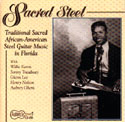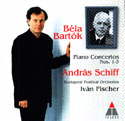| |






|
|
|
by
Geary Kaczorowski
 |
There were so many wonderful recordings to cross my desk the past month that I felt it necessary to pare it down to pretty much religion and Bartók. Smithsonian Folkways put out an incredible African-American spirituals collection, Arhoolie released an album of sacred songs played on steel guitar and a strange recording by Unesco of religious traditions in Viet Nam. For Bartók there were new recordings of his duos for violin, and three piano concertos. And I top off the section off with a special CD of some surprisingly dark Ralph Stanley tracks.
Enjoy the musical Tension.
 Various Artists
Various Artists
Wade in the Water: African-American Sacred Music Traditions
Smithsonian Folkways
This four-CD set covers the widest swath of traditional African-American gospel as Iíve ever seen. Vol. I is gospel in concert, Vol. II looks at congregational singing, Vol. III deals with the pioneering composers of the genre and Vol. IV delves into the world of community gospel. Each volume comes with a well referenced booklet containing all manner of recording and historical information. And of course, the recordings themselves are of the highest quality. In collaboration with National Public Radio, Wade in the Water is an essential contemporary updating of African-American gospel traditions, with roots back to Africa, that encompasses sacred songs from the 19th and 20th century. Starting with the Fisk College Students in 1871, through various gospel styles--ring shouts and call and response songs--to composers of such works as "Stand by Me," "Does Jesus Care," and "Precious Lord," to the ensemble singing of the African-American community, Wade in the Water delivers powerful performances of some of the most beloved sacred songs this country has ever known. The performers are some of the best and brightest of todayís generation of gospel singers and groups shouting high unto the Lord with conviction and spirit. The Princely Players ply their trademark concert style through a number of traditional songs like "Gospel Train," and "Go in the Wilderness," while The Poole Brothers do the community thing with verve and excitement on "A Charge to Keep I Have." The United Southern Prayer Band of Baltimore, Washington, and Virginia wends its congregational way through "I Heard the Voice of Jesus Say," and "I am a Soldier in the Army of the Lord," and Sweet Honey in the Rock lend their smoothly religious vocal talents to "Just a Closer Walk with Thee." These are just some of the highlights from a set chock full of gospel gems. For aficionados of gospel music, particularly the African-American styles and traditions, Wade in the Water is a must.
 Various Artists
Various Artists
Sacred Steel: Traditional Sacred African-American Steel Guitar Music in Florida
Arhoolie
It sounds like rollicking surf music, and rockiní blues and spirited gospel, but what it is is Sacred Steel. In the Holiness-Pentecostal churches of Florida, masters of the electric steel guitar ply their trade to the music of the Lord. Sound a little unusual? Well, it is. Sort of. If you have always thought of gospel music as a single voice shouting out to the Lord, or a choir of angelic voices rising above the pumping melodies of an organ, then you have to change your perception. This has to be the most unusual presentation of sacred songs that I have ever heard. The first three tracks are instrumentals that remind one of surf music in its most primal form. Sonny Treadway, master guitarists at Church of the Living God in Deerfield, Florida works his string magic around three standards employing his steel guitar, another electric guitar and drums. The next three tracks are instrumentals tackling gospel from a blues perspective. Glenn Lee from the House of God Church in Perrine, Florida adds an electric bass to his mix of original compositions and a standard. Next, Willie Eason works in both a solo steel guitar and vocal setting or with drums. Here he has created rock and roll renditions of "Just a Closer Walk with Thee," "Little Wooden Church on a Hill," and a spectacular performance of his original track, "Franklin D. Roosevelt, a Poor Manís Friend." Sonny Treadway returns to perform five more tracks, this time with vocalists, but the surf atmosphere still prevails. Heís the real star of this collection as his harmonic balance and tone on the electric steel guitar are impeccable on each of his tracks. The last five songs on the recording employ more of the traditional gospel elements such as choir and keyboards, but the overriding element is the steel guitar and its odd placement among this style of music. Each track, recorded within the last three or four years, is something I never would have guessed. Itís not that the performances sound dated--they donít at all--itís just that I when I first listened to this release I thought gospel music this curious couldnít possibly be new. Actually, using an electric steel guitar to perform sacred songs goes back some sixty years and seems to be inspiring a whole new crop of practitioners. A great booklet comes with this CD containing a brief history of the electric steel guitar in this type of setting, a history of the churches of Florida that use it, and a discography of the musicians performing.
 Various Artists
Various Artists
Viet Nam: Traditions of the South
Unesco
This intricately played recording contains various groupings of Vietnamese religious song stylings: ceremonial music ("Bai Trong Lay and Thet"), Buddhist chants ("Bai Ha"), spirit possession ("Châu Moi Tâ Nuong"), and folksongs ("Phong Xuy Trich Liêu"). Utilizing traditional Vietnamese instruments, this mix of artists, most prominently Tu Huyen on drums, fiddle and flute, and Hai Phat on oboe and fiddle, carry listeners dramatically through the world of Vietnamese village life, from births through lives fulfilled to funerals. The overriding themes here is the religiosity the peasants bring to each aspect of life, placing faith in Buddha to see them through the turmoilís and turns of life. Most tracks are complex instrumentals, but when the vocals appear, most notably Mrs. Mong Trung, and Miss Bach Huê the music takes on a personal atmosphere, less complicated, yet not any less compelling. The sound of the traditional instruments will seem odd to western ears at first, yet given the chance to sink in the sounds become lyrical and the pleasure of listening heightened.

 Alberto Lysy/Sophia Reuter
Alberto Lysy/Sophia Reuter
Bartók: 51 Duos for Two Violins
Dinemec Classics
András Schiff/Budapest Festival Orchestra/Iván Fischer (conductor)
Béla Bartók: Piano Concertos Nos. 1-3
Teldec
After the success of Bartókís "For Children" (1909) and "Mikrokosmos" (1926-1939) he was asked by a violin teacher, Erich Doflein, to contribute a duet for unaccompanied violins for a manual he had written, with his wife, on violin playing. The duo Bartók contributed turned out to be much harder to play than Doflein had anticipated so Bartók eventually contributed duos that were easier and easier until this collection was complete. This collection, as played by the master Argentinean violinist Alberto Lysy and his protégé Sophia Reuter, includes seven more duos that were constructed by other composers from fragments and ideas Bartók had left, so their inclusion here really doesn't make much sense. The original 44 duos (1933) completely play into the notion Bartoók had of preserving folkmusic from his native Hungary. Each is from a peasant melody and covers not only the whole of Central Europe, but includes a couple military pieces that suggest Western Russia. In the hands of Lysy and Reuter each duo blends seamlessly to create one major work. They handle the intricacies of each with skill and style that is rarely given to these pieces. Listening to these pieces it is easy to hear all the various nuances Bartó brought to all of his works. The playful interaction of Lysy and Reuter contribute to the mood and essence Bartó was trying to create with these pieces, evoking a time long forgotten for many. Short and sweet, each duo sounds so delicate in nature, that to play them any way other than Lysy and Reuter would render them meaningless.
I found Bartókís three piano concertos to be some of the most movingly powerful music yet created. András Schiff is able to perfectly maneuver through the complexities of the pieces, much in the same manner Bartók would have when he wrote them. Nos. 1 & 2 where written specifically for Bartók as the pianist, and Schiff has studied the recordings of Bartók performances and been able to adopt his stylistic lushness. There are many references to Stravinskyís ostinatos in each of these two pieces, and the use of percussion along with the piano forms the basis of each. There also appears to be Hungarian musical references, as when the piano and timpani join together for the large middle Adagio-Presto-Adagio of No. 2. Schiff is able to transcend each section, never becoming lost in the intricacy, and to bring each concerto to its logical, robust conclusion. No. 3 was written with Bartókís wife Ditta in mind as the pianist, and as such is an easier piece to play. The middle section, the Adagio religioso, is as intricate and potent as anything you are likely to ever hear. Schiff and the orchestra work in tandem, heightening the atmosphere as they tear through the musical references to Beethoven and Bach. Taken as a whole, the three piano concertos represent some of the most important compositions of Bartókís career.
 Ralph Stanley
Ralph Stanley
Short Life of Trouble: Songs of Grayson and Whitter
Rebel
If you thought Nick Cave had cornered the market on bleak songs that explored the dark, seamy nature of humans then you should give this album a couple hundred spins. Ralph Stanley wraps his trademark banjo and stunning vocals around the powerful songwriting of Gilliam B. Grayson and Henry Whitter, turning them into classic tracks of losers, has-beens and plain folk living a life less than ideal. With only a two year recording career, 1927-1929, Grayson & Whitter put to vinyl some 40 songs with an observant eye into the often-times violent life in the Appalachian Mountains. Nothing seems to be easy in this southern mountainous region and G&W are able to bring to life characters that would be welcome in a David Lynch film. There's murder, deceit, cheating, drinking, and broken dreams that dart in and out of these songs, and it makes one wonder if Cave isn't intimately familiar with G&W's body of work. Stanley, along with his crack band featuring the amazing James Price on fiddle, brings a musical conviction to each song, building the tension higher and higher within the action of the songs to make them even more harrowing than they at first seem. The musical background is actually lighthearted for most of the album, but if you start listening closely you'll hear the tale of a lover throwing his girlfriend's body into the river ("Rose Conley"), the story of a loner with nothing to lose in this life ("Nobody's Darling"), and zombies that walk the Earth ("He's coming to Us Dead"). Some more real highlights here include "Train 45", "Joking Henry" and "Nine Pound Hammer." It's a walk on the dark side in bluegrass that you won't soon forget.
|
|
Tension |
February/March 1997 |
|
|